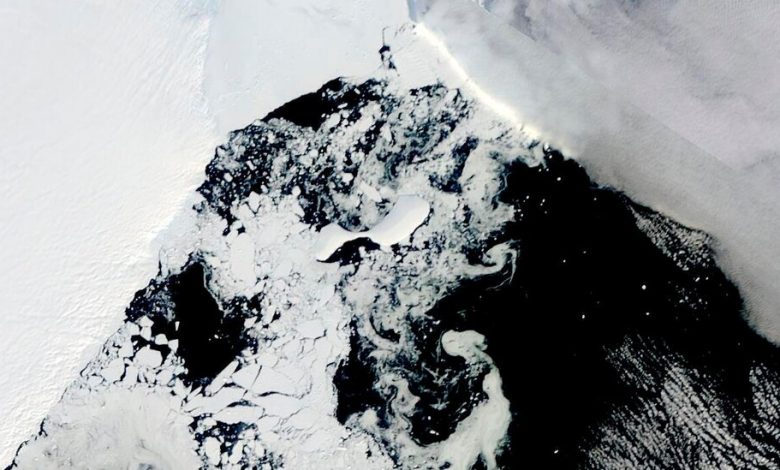Rapid Antarctic Melting Looks Certain, Even if Emissions Goals Are Met

At the bottom of the world, the floating edges of one of the enormous ice sheets covering Antarctica are facing an invisible threat, one that could add to rising sea levels around the globe. They are melting from below.
As the planet warms, larger volumes of warm water are bathing the undersides of West Antarctica’s ice shelves, the giant tongues of ice at the ends of glaciers. The sheer mass of these shelves stops the ice on land from flowing more quickly into the open sea. So as the shelves melt and thin, more of the land ice moves toward the ocean, eventually contributing to sea level rise. Curbing fossil fuel emissions might help slow this melting, but scientists haven’t been sure by how much.
Now, researchers in Britain have run the numbers and come to a sobering conclusion: A certain amount of accelerated melting is essentially locked in. Even if nations limited global warming to 1.5 degrees Celsius, or 2.7 Fahrenheit, it wouldn’t do much to halt the thinning. Staying below 1.5 Celsius is the most ambitious aim of the Paris Agreement, and at the moment, it is unlikely to be achieved.
“It appears that we may have lost control of the West Antarctic ice-shelf melting over the 21st century,” one of the researchers, Kaitlin A. Naughten, an ocean scientist with the British Antarctic Survey, said at a news briefing. “That very likely means some amount of sea level rise that we cannot avoid.”
The findings by Dr. Naughten and her colleagues, which were published Monday in the journal Nature Climate Change, add to a litany of gloomy prognostications for the ice on the western side of the frozen continent.
Two of the region’s fastest-moving glaciers, Thwaites and Pine Island, have been losing vast amounts of ice to the ocean for decades. Scientists are trying to determine when greenhouse emissions might push the West Antarctic ice sheet past a “tipping point” beyond which its collapse becomes rapid and hard to reverse, imperiling coastlines worldwide in the coming centuries.
Even so, cutting emissions of heat-trapping gases could still stop even greater amounts of Antarctic ice from being shed into the seas. The East Antarctic ice sheet contains about 10 times as much ice as the West Antarctic one, and past studies suggest that it is less vulnerable to global warming, even if some recent research has challenged that view.
“We can still save the rest of the Antarctic ice sheet,” said Alberto Naveira Garabato, an oceanographer at the University of Southampton who wasn’t involved in the new research, “if we learn from our past inaction and start reducing greenhouse gas emissions now.”
Dr. Naughten and her colleagues focused on the interplay between the ice shelves and the water in the Amundsen Sea, which is the part of the Southern Ocean that washes up against Thwaites and Pine Island glaciers.
The researchers first used computer simulations to estimate changes in ocean temperature and the resulting ice-shelf melting that took place there in the 20th century. They then compared this with potential changes under several pathways for global warming in the 21st century, from highly optimistic to unrealistically pessimistic.
They found that the water at 200 to 700 meters, or 650 to 2,300 feet, beneath the surface of the Amundsen Sea could warm at more than three times the rate in the coming decades compared with the last century, pretty much regardless of what happens with emissions.
If global warming were limited to 1.5 degrees Celsius compared with preindustrial conditions, temperatures in the Amundsen would flatten out somewhat after about 2060. In the most calamitous emissions trajectory, by contrast, ocean warming would accelerate even more after 2045.
The reason the differences aren’t bigger is that water temperatures in this part of the Southern Ocean are influenced not just by human-driven warming of the atmosphere, but also by natural climate cycles such as El Niño, Dr. Naughten said. The differences under the various emissions trajectories, she said, are small by comparison.
The study is unlikely to be the last word on the fate of the West Antarctic ice shelves. Scientists began collecting data on melting there only in 1994, and, because of the difficulty of taking measurements in such extreme conditions, the data is still sparse.
“We are relying almost entirely on models here,” Dr. Naughten said.
When mathematical representations of reality are the best option available, scientists prefer to test their hypotheses using multiple ones to make sure their findings aren’t the product of a given model’s quirks. Dr. Naughten and her colleagues used only a single model of the interactions between ice and ocean.
Still, their study’s methods are broadly in line with past findings, said Tiago Segabinazzi Dotto, a scientist with the National Oceanography Centre in Britain who wasn’t involved in the new research.
This gives coastal societies reason to take the study’s predictions seriously and to plan for even higher sea levels, he said.



